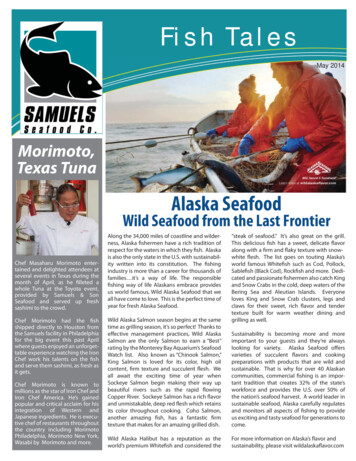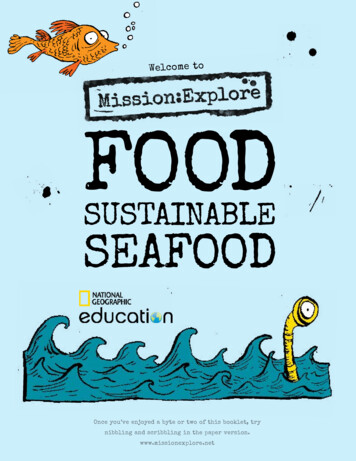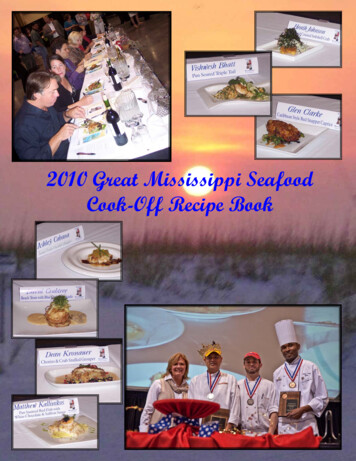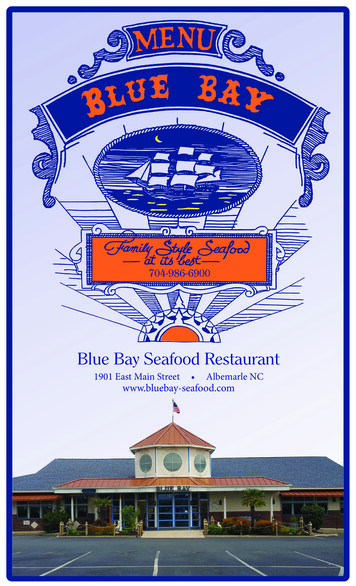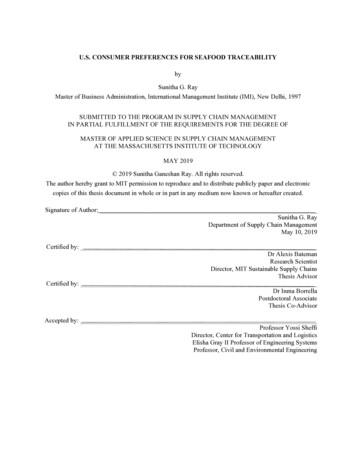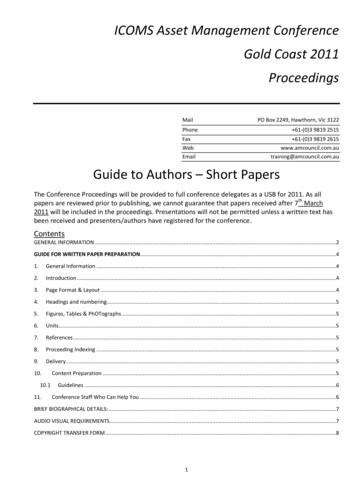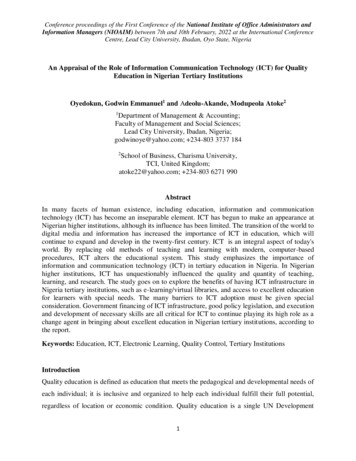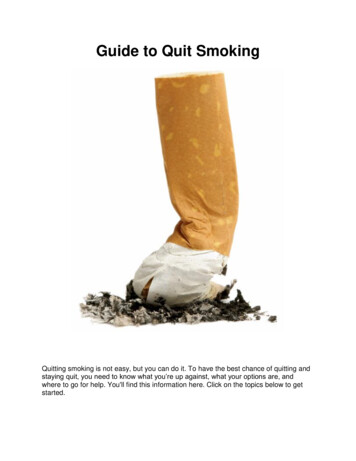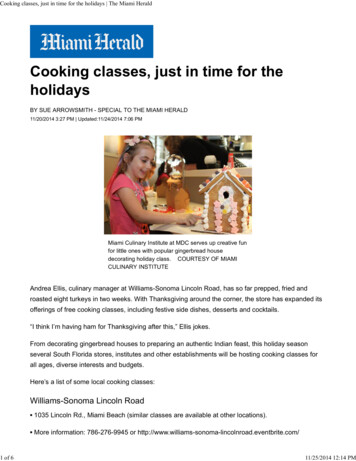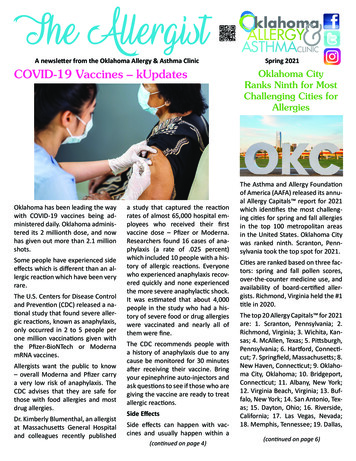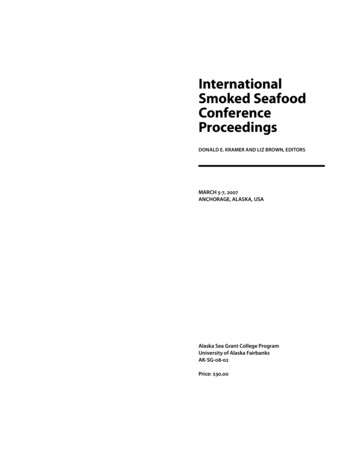
Transcription
InternationalSmoked SeafoodConferenceProceedingsDonald E. Kramer and Liz Brown, EditorsMARCH 5-7, 2007ANCHORAGE, ALASKA, USAAlaska Sea Grant College ProgramUniversity of Alaska FairbanksAK-SG-08-02Price: 30.00
Elmer E. Rasmuson Library Cataloging in Publication Data:International smoked seafood conference proceedings /Donald E. Kramer and Liz Brown, editors.— Fairbanks : Alaska Sea Grant Program, University ofAlaska Fairbanks 2008.p. : ill. ; cm. (Alaska Sea Grant College Programreport ; AK-SG-08-02.)“March 5-7, 2007, Anchorage, Alaska, USA.”Includes bibliographical references.ISBN 978-1-56612-127-91. Seafood—Congresses. 2. Smoked fish—Congresses. 3.Smoked food—Congresses. I. Title. II. Kramer, DonaldE. III. Brown, Liz, 1959- IV. Series: Alaska Sea GrantCollege Program report ; AK-SG-08-02.TX385.I58 2008CreditsThis book is published by the Alaska Sea Grant CollegeProgram, supported by the U.S. Department of Commerce,NOAA National Sea Grant Office, grant NA06OAR4170013,projects A/161-01 and A/151-01, and by the University ofAlaska Fairbanks with state funds. Funding for the publication was also provided by the Alaska Fisheries DevelopmentFoundation and California Sea Grant. The University ofAlaska is an affirmative action/equal opportunity employerand educational institution.Sea Grant is a unique partnership with public and private sectors combining research, education, and technology transferfor public service. This national network of universities meetschanging environmental and economic needs of people inour coastal, ocean, and Great Lakes regions.Sue Keller edited and managed book production, and JenGunderson designed and formatted the text pages and thecover. Cover photo 2008 Jupiterimages Corporation.Alaska Sea Grant College ProgramUniversity of Alaska FairbanksP.O. Box 755040Fairbanks, Alaska 99775-5040Toll free (888) 789-0090(907) 474-6707 fax (907) 474-6285www.alaskaseagrant.orgAlaska
ContentsAcknowledgments.vSmoked Seafood SafetyListeria monocytogenes: A Challenge for the Smoked Seafood IndustryMartin Wiedmann and Ken Gall.1Clostridium botulinum ConcernsMary Losikoff.5Staphylococcus aureus Concerns in Smoked FishBrian H. Himelbloom. 9A Review: Processing Parameters Needed to Control Pathogens in Cold Smoked FishMichael Jahncke. 15Bacteriophage Control of Pathogens in FoodsJenny Scott and Yuhann Chen.23Pellicle Formation and Inactivation of Listeria andStaphylococcus Species in Hot-Smoking of SalmonBrian H. Himelbloom, Chuck Crapo, Thombathu S. Shetty, and Carey Vorholt.27Regulatory StandardsInternational Regulatory Requirements for SmokedFish: Europe and Codex AlimentariusTimothy Hansen.35HACCP PlanJim Vik.39Compliance with FDA’s HACCP RegulationChristopher E. Rezendes.43Process Establishment or Validation for Refrigerated, Vacuum-PackagedHot-Smoked Fish, and HACCP Monitoring ConsiderationsJoe Frazier.47Common Mistakes in HACCP for Hot Smoked SalmonLiz Brown.53Production and PackagingWood Smoke Components and Functional PropertiesRomeo T. Toledo.55Introduction to Smoke CondensatesJeffrey J. Rozum.63Food Engineering Applications in Seafood ProcessingSubramaniam Sathivel.65iii
ContentsDevelopment and Characterization of Vacuum Packaged Alaska PinkSalmon (Oncorhynchus gorbuscha) Jerkies Made with MarinadesA.C.M. Oliveira, C.A. Crapo, B.H. Himelbloom, A. Morey, and A. Ambardekar.67Using Sustainable Packaging Technologies to Respond toConsumer, Retailer, and Seafood Industry NeedsBarbara Blakistone and Claire Koelsch Sand.75Use of Antimicrobial-Coated Plastic Films to Control Listeriamonocytogenes on Cold-Smoked SalmonHudaa Neetoo, Mu Ye, and Haiqiang Chen.81Business and MarketingGlobalization and Aquaculture: Challenges, Opportunities,and Questions for the Smoked Seafood IndustryGunnar Knapp.91Fishing for Answers? Consult the Internet!Pamela D. Tom.95Planning, Constructing, and Managing a CommunityFreezing and Cold Storage Facility: A Case StudySunny Rice and Eric Philips. 99RFID: How It Will Transform Packaging, Distribution,and Handling of Alaska SeafoodStephen T. Grabacki, Mike Ronchetti, Thane Humphrey, and Oliver Hedgepeth. 101USDA Rural Development: Value Added Producer Grant (VAPG) ProgramKaren Dearlove. 107Innovations in Alaska Smoked Seafood as Showcasedthrough the Alaska Symphony of SeafoodBob Pawlowski and Jim Browning.111Participants.115iv
AcknowledgmentsThe International Smoked Seafood Conference was held inAnchorage, Alaska, March 5-7, 2007.Steering CommitteeConference SponsorsLiz Brown, Don Kramer, and Sunny Rice,Alaska Sea Grant Marine Advisory ProgramSherri Pristash, Alaska Sea Grant College ProgramPamela Tom, California Sea Grant Extension ProgramAlaska Fisheries Development FoundationAlaska Sea GrantAlaska Seafood Marketing InstituteCalifornia Sea GrantPollock Conservation Cooperative Research CenterPURAC America Inc.State of Alaska Fisheries Revitalization StrategyWashington State University Extension and University ofMinnesota Center for Farm Financial ManagementTechnical Program CommitteeDon Kramer (co-chair), Alaska Sea Grant Marine AdvisoryProgram, University of Alaska FairbanksPamela Tom (co-chair), California Sea Grant ExtensionProgram, University of California DavisJeff Berger, Deep Creek Custom PackingBarbara Blakistone, National Fisheries InstituteLiz Brown, Alaska Sea Grant Marine Advisory Program,University of Alaska FairbanksJim Browning, Alaska Fisheries Development FoundationBob Collette, National Fisheries InstituteChuck Crapo, Alaska Sea Grant Marine Advisory Program,University of Alaska FairbanksGeorge Flick, Virginia Polytechnic InstituteKen Gall, New York Sea Grant, Cornell UniversityKenny Lum, Food Products AssociationDuane McIntire, Ocean Beauty Seafood, Inc.Russ Miget, Texas Sea Grant, Texas A&M UniversityRandy Rice, Alaska Seafood Marketing InstituteTom Rippen, Maryland Sea Grant, University of MarylandLewis Shuckman, Shuckman’s Fish Company & Smokeryv
International Smoked Seafood Conference ProceedingsAlaska Sea Grant College Program AK-SG-08-021Listeria monocytogenes: A Challengefor the Smoked Seafood IndustryMartin WiedmannDepartment of Food Science, Cornell University, Ithaca, New YorkKen GallCornell University and New York Sea Grant, Stony Brook, New YorkResearch summaryListeria monocytogenes causes an estimated 2,000 to 2,500cases of illness per year in the United States. Since about 20to 30% of listeriosis patients die, this is one of the most severefood-borne diseases. Susceptible individuals (e.g., immunocompromised people and pregnant women) can experiencesevere disease, including abortions and brain infections,when exposed to high numbers of this bacterium. L. monocytogenes and the disease caused by it have a number ofcharacteristics that complicate efforts to reduce food-bornelisteriosis infections.The almost ubiquitous presence of the organism,including in urban and natural environments, farms, andprocessing plants, provides a high risk for introduction intofoods at any point of the farm-to-table food continuum. L.monocytogenes’ ability to multiply in foods at refrigerationtemperatures allow this organism to reach high numbers,particularly if foods that otherwise allow its growth (e.g., byhaving suitable pH and water activity) are stored for prolonged times at refrigeration temperatures. If these foods arenot heated before consumption (as is generally the case forready-to-eat foods) consumers can then be exposed to high L.monocytogenes numbers. The long incubation period for listeriosis (7 to 60 days) makes it difficult to identify the sourcesof infection and therefore complicates efforts to identify andeliminate sources of human infections.We have used molecular subtyping methods (as reviewedby Wiedmann 2002) to explore the sources and spread ofL. monocytogenes in a variety of environments (e.g., Kabukiet al. 2004) including in smoked seafood processing plants(Hoffman et al. 2003, Lappi et al. 2004). While we found avariety of different transient L. monocytogenes subtypes inmany plants, a specific L. monocytogenes subtype or subtypesthat persist in the processing environment was also identifiedin most processing plants. These persistent subtypes appearto be the major cause of finished product contamination.While molecular subtyping helped identify likely nichesfor persistent subtypes, control and eliminations of thesepersistent L. monocytogenes appears to represent a majorchallenge in all sectors of the food industry. In addition,we identified considerable variation in Listeria contamination patterns in a smoked seafood plant within a given dayand within a given shift. This further complicates Listeriacontrol efforts, and indicates the importance of randomevents in Listeria transmission (Hu et al. 2006). Despitethese considerable challenges, long-term efforts to controlL. monocytogenes in one plant led to a reduction of L. monocytogenes prevalence to approximately one-tenth, indicatingthat improved control of this pathogen in the seafood industry is possible.Control strategies for smokedseafood processorsListeria monocytogenes can survive for long periods of timein the processing plant environment. It may be introducedinto processing plants through a variety of routes, includingraw materials, employees, and equipment. Listeria speciestend to form a biofilm, which enhances its survival when resident populations become established in niches in the plant.General cleaning and sanitizing procedures do not easilyeliminate these resident populations.Implementing an effective Listeria control programis a long-term commitment. Based on our current understanding, at least five key elements need to be included inan effective L. monocytogenes control program for ready-toeat seafood products like smoked fish. These five elementsinclude (1) Listeria specific good manufacturing practices(GMPs) and sanitation procedures, (2) employee training, (3)environmental microbiological monitoring and testing, (4)raw material controls, and (5) controls to minimize growthin the finished products.The Smoked Seafood Working Group (SSWG), a collaboration of two national industry trade organizations, the U.S.National Fisheries Institute and National Food ProcessorsAssociation, smoked seafood processors, and academia,developed guidelines to minimize Listeria monocytogenescontamination of finished products in smoked seafood operations. These guidelines have been adopted by reference inthe Association of Food and Drug Officials’ Cured, Saltedand Smoked Fish Good Manufacturing EstablishmentsGMPs (AFDO 2004). The SSWG (2002) Listeria ControlManual can be downloaded from the following CornellUniversity Web site: http://www.foodscience.cornell.edu/
2Wiedmann and Gall—Listeria monocytogenes and Smoked a-employeetraining-program.cfm. The control strategies developed bythe SSWG for Listeria-specific GMPs and sanitation controls, employee training, microbiological testing of the plantenvironment, raw materials and finished products, and antimicrobial treatments for raw material and finished productshave been published in a series of four papers in the peerreviewed journal of the International Association for FoodProtection, Food Protection Trends.An Institute of Food Technologists’ expert panel statedthat reduction of L. monocytogenes in the processing plantwas directly dependent on adherence to good hygienicpractices (GHPs) and GMPs (IFT 2001). Targeted good manufacturing practices and sanitation procedures to minimizeListeria contamination of smoked seafood products are summarized in Gall et al. 2004. These procedures include steps toprevent cross contamination caused by improper design andlayout of processing operations, the movement of people andequipment in the plant, inadequate employee hygiene, andpoor food handling practices. Cleaning and sanitation procedures for equipment and the processing plant environmentthat are designed to specifically target Listeria contamination are also described.Training plant personnel is another key element ofthe complete Listeria control program identified by theSSWG. Examples of targeted training programs for all plantemployees, those employees who work with exposed finishedproducts, and employees who conduct cleaning and sanitation procedures are described in Hicks et al. 2004. Threedifferent PowerPoint training programs that are designedto train employees in each of these groups in the plantenvironment can be downloaded free of charge at the following Cornell University Web site: gram.cfm.Another element of a complete Listeria control program that smoked seafood processors may need to consideris treatment with antimicrobial agents to reduce the amountof Listeria on raw seafood products or treatments to inhibitits growth on finished packaged smoked seafood products.A scientific and practical review of the various antimicrobialtreatment options that may be available to smoked seafoodprocessors is provided in Jahncke et al. 2004.Environmental testing for Listeria can be used to helpidentify problem areas or locate contamination sources inthe processing plant, and to confirm that problem solvingprocedures have been effective. It may also be necessary insome circumstances to test raw materials and finished products. Guidelines for Listeria testing of environmental and rawand finished product samples in a smoked seafood processing environment are provided in Scott et al. 2005.Controlling Listeria monocytogenes in both cold and hotsmoked seafood products can be a significant challenge. Forcold smoked products, the heat applied during the smokingprocess is not sufficient to kill Listeria, so controls must bein place to minimize Listeria contamination of raw materials and at all steps of the process. Hot smoked productsare subjected to a heat treatment that is lethal to Listeria,but these products are susceptible to contamination fromthe plant environment after smoking. Thus control effortsshould focus on preventing contamination after the hotsmoking step.Each firm needs to evaluate their unique situation andimplement targeted control strategies for their plant environment and the products that they produce. The resourceslisted in the references below can be used by smoked seafoodprocessors to help them build an appropriate science-basedListeria control program.ReferencesAFDO. 2004. Cured, salted and smoked fish establishments GMPs.Association of Food and Drug Officials. Available at http://www.afdo.org/afdo/publication/printed.cfm. (Accessed Nov.2007.)Gall, K., V.N. Scott, R. Collette, M. Jahncke, D. Hicks, and M.Wiedmann. 2004. Implementing targeted good manufacturing practices and sanitation procedures to minimize Listeriacontamination of smoked seafood products. Food ProtectionTrends 24(5):302-315.Hicks, D., M. Wiedmann, V.N. Scott, R. Collette, M. Jahncke, andK. Gall. 2004. Minimizing Listeria contamination in smokedseafood: training plant personnel. Food Protection Trends2(12):953-960.Hoffman, A., K. Gall, D. Norton, and M. Wiedmann. 2003. Listeriamonocytogenes contamination patterns for the smokedfish processing environment and for raw fish. J. Food Prot.66:52-60.Hu, Y. K. Gall, A. Ho, R. Ivanek, Y.T. Gröhn, and M. Wiedmann.2006. Daily variability of Listeria contamination patternsin a cold-smoked salmon processing operation. J. Food Prot.69:2123-2133.IFT (Institute of Food Technologists). 2001. Processing parameters needed to control pathogens in cold-smoked fish.Scientific and technical panel: F. Busta, G. Bledsoe, G. Flick,L. Gram, D. Herman, M. Jahncke, and D. Ward. J. Food Sci.66(7):S-1059-S-1132.Jahncke, M., R. Collette, D. Hicks, M. Wiedmann, V.N. Scott, andK. Gall. 2004. Treatment options to eliminate or control thegrowth of Listeria monocytogenes on raw material and on thefinished product for the smoked fish industry. Food ProtectionTrends 24(8):612-619.Kabuki, D.Y., A.Y. Kuaye, M. Wiedmann, and K.J. Boor. 2004.Molecular subtyping and tracking of Listeria monocytogenesin Latin-style fresh cheese processing plants. J. Dairy Sci.87:2803-2812.
International Smoked Seafood Conference ProceedingsLappi, V.R., J. Thimothe, K. Kerr Nightingale, K. Gall, V.N. Scott,and M. Wiedmann. 2004. Longitudinal studies on Listeria insmoked fish plants: Impact of intervention strategies on contamination patterns J. Food Prot. 67:2500-2514.Scott, V.N., M. Wiedmann, D. Hicks, R. Collette, M. Jahncke, andK. Gall. 2005. Guidelines for Listeria testing of environmental,raw product and finished product samples in smoked seafoodprocessing facilities. Food Protection Trends 25(1):23-34.3SSWG. 2002. Listeria monocytogenes control manual draft 9.Smoked Seafood Working Group of the National FisheriesInstitute and National Food Processors Association. Availableat ogram.cfm.(Accessed Nov. 2007.)Wiedmann, M. 2002. Molecular subtyping methods for Listeriamonocytogenes. J. AOAC International 85:524-531.
International Smoked Seafood Conference ProceedingsAlaska Sea Grant College Program AK-SG-08-025Clostridium botulinum ConcernsMary LosikoffU.S. Food and Drug Administration, College Park, MarylandClostridium botulinum is a group of culturally distinctorganisms that produce similar toxins. It is an anaerobicspore-forming bacterium and the toxin produced is a neurotoxin that is considered one of the most potent naturallyoccurring toxins known. The vegetative cells and the toxinare susceptible to heat, while the spores can be heat resistantand can survive adverse conditions. The bacteria are widelydistributed in nature in soils; sediments of streams, lakes,and coastal waters; the intestinal tracts of fish and mammals;and the gills and viscera of crabs and other shellfish.There are seven types of C. botulinum—A, B, C, D, E, F,and G—while only four of those, A, B, E, and F, cause humanbotulism. There is a low incidence of disease but the mortality rate is high if the symptoms are not immediately treated.The onset of symptoms is from 18 to 36 hours and early signsare weakness and vertigo, leading to progressive paralysis.Some victims experience abdominal distention and constipation. Victims will experience double vision, and difficultyin speaking and swallowing and breathing, eventually leading to inhibited respiration and death from asphyxia. Casesmay be under-diagnosed or missed entirely because the disease can occur as a single case and the symptoms are similarto other illnesses, such as stroke. Treatment includes earlyadministration of botulinal antitoxin and mechanical ventilation. Early administration is important because the antitoxinworks against toxin that has not bound to the nerve ending.Two to eight weeks of ventilation support is common.C. botulinum is also differentiated by its ability todegrade proteins. The proteolytic strains (A, B, F) willdegrade proteins, leaving visual signs of growth. The limitfor growth (temperature below which it will not grow) forthe proteolytic strains is 10 C (50 F). The non-proteolyticstrains (B, E, F) do not degrade protein so the product maybe toxic without signs of growth. The limit for growth forthe non-proteolytic strains is 3.3 C (38 F) which is belowrecommended refrigeration temperatures. The strains mostcommonly associated with seafood products and the marineenvironment are non-proteolytic with type E of particularconcern.The organisms are ubiquitous in the environment. Nonproteolytic strains of C. botulinum were found in 42.6% ofPacific rockfish and salmon sampled in a 1990 study. Thebacteria were primarily found in the guts and gills so evisceration is a key to control. Table 1 shows examples of levelsof spores found in several species of fish.The United States has relatively low incidences offood-borne botulism cases, with CDC reporting 1,087 casesTable 1.Clostridium botulinum spore levels in fish.FishStrainSpore levelPacific rockfish (red snapper)A9-240/100 gSalmonA4-120/100 gHerringE100/100 gFarm raised trout from SwedenE530/100 g(Baker et al. 1990)in 444 outbreaks recorded between 1950 and 1996. An outbreak is defined as one or more cases of botulism where afood source is implicated. There is an average of 2.5 casesper outbreak. Of these 444 outbreaks, 37.6% were type A,13.7% were type B, 15.1% were type E, 0.7% were type F, and32.9% were unknown. Five states (California, Washington,Colorado, Oregon, Alaska) are responsible for more than half(53.8%) the outbreaks. When you isolate data from 1990-1996outbreaks, type A was responsible for 44.6%, type E for 35.7%,and type B for 12%. This may be due to better isolation techniques. Earlier in the century, there was a 60% fatality rate.Between 1950 and 1996, the fatality rate dropped to 15.5%,which could be due to improvements in respiratory intensivecare and the prompt administration of antitoxin. Alaska wasresponsible for 16.2% of outbreaks nationwide between 1950and 1996, largely due to improper preparation and storage ofAlaska Native foods. Fifty-six (83.6%) of the nationwide typeE outbreaks took place in Alaska.Selected cases in the United StatesEarly in the 1960s, there were three episodes of botulismfrom vacuum packaged smoked fish from the Great Lakes,which resulted in 21 cases with nine deaths. In 1987, consumption of Kapchunka, an uneviscerated, air-dried wholewhitefish caused eight cases of botulism in New York andIsrael with one death. In Hawaii, in 1990, three peoplebecame ill after consuming grilled palani. The investigationshowed that apparently toxin was formed in the raw fish afterit was temperature abused in the market; the heat appliedduring cooking did not inactivate the botulinal toxin.Selected case studyThis incident in Europe provides an overview of a relativelyrecent case of botulism in a commercially prepared smoked
6fish product. The authors of the study referred to vacuumpackaged hot-smoked fish as “one of the most important botulism food vehicles processed on an industrial scale.” In 1997,a family of three ate from a package of vacuum packed, hotsmoked whitefish. The wife, who consumed two-thirds ofthe fish, became ill in 7.5 hours. In 13.5 hours the husbandexperienced symptoms, while the two-year-old grandchildwas unaffected. The couple said the fish “tasted good.” Theremains of the package were positive for type E C. botulinum and toxin. Eleven other samples from same lot testednegative. This suggests that contamination can be spotty andfood processors must take care to ensure that smoked fishin each package is properly brined, smoked, and heated. Thewhitefish had been processed five days prior to consumption.The process included thawing the raw product in cold water,brining for ten hours at 5 C, drying at 40 C for 30 minutes,and smoking in four steps between 60 and 75 C for abouttwo hours. The resulting product had a water phase salt levelof 1.8% and was sold in Germany and Finland. There wereno documented product temperatures from the processoror the distribution chain, but when measured later, storagetemperatures ranged from 2 to 5 C. Conclusions from theinvestigation indicated low water phase salt (wps) with noobvious temperature abuse. There was some indication thatthe processing, storage, and transport information may nothave been correct and there was a possibility of preformedtoxin. The lack of specific information demonstrates thevalue of accurate HACCP records.The hazard of C. botulinum in seafood products is regulated through the Seafood HACCP Regulation (21 CFR Part123), and guidance to the industry is provided in the Fish andFishery Products Hazards and Controls Guide, 3rd edition,2001. A new edition is expected to be published in 2008. Theguide addresses the C. botulinum hazards associated with theuse of reduced oxygen packaging, including vacuum packaging, modified atmosphere packaging, hermetically sealedcontainers (e.g., double seamed cans and glass jars with lids),deep containers from which air is expressed, and productspacked in oil. FDA’s concern is that the use of reduced oxygen packaging (ROP) may extend shelf life by inhibiting thegrowth of aerobic spoilage organisms, and the anaerobic conditions created may allow the growth and toxin productionby non-proteolytic strains of C. botulinum at refrigerationtemperatures without visible signs of spoilage.Controls to prevent the growth of C. botulinum includefreezing (where labeling is a key), heating (sufficiently toinactivate spores), acidifying, reducing the water activitythrough drying, adding chemicals such as salt, refrigeratingthe food, or some combination of these factors. The controlsfor complete inhibition differ between proteolytic and nonproteolytic strains as shown in Table 2.Heat can be used to eliminate non-proteolytic strains ofC. botulinum when it is applied to product in the final package (pasteurization). The product is then refrigerated at 4.4 C(40 F) to prevent the outgrowth of other pathogens and theLosikoff—Clostridium botulinum ConcernsTable 2.Controls for complete inhibition of Clostridium botulinumproteolytic and non-proteolytic strains.Proteolytic strains A, B, FNon-proteolytic strains B, E, FpH 4.6 5.0aW 0.94 0.97NaCl10% wps5% wpsMin temp. 10 C (50 F)3.3 C (38 F)SporeHigh: D valueheat121 C 0.23 minresistanceLow: D value82.2 C 1.2 minproteolytic strains of C. botulinum. Products that have beensuccessfully treated in this manner include surimi analogs,pasteurized crabmeat, and cooked shrimp.Non-proteolytic strains are completely inhibited in fishsalted to a 5.0% wps, acidified with a pH of 5.0 or less, orwater activity controlled below 0.97. In each case the productmust be refrigerated at 40 F (4.4 C) to inhibit other pathogens that may be present, including proteolytic strains of C.botulinum. Chemical inhibitors can also be used at lowerlevels against non-proteolytic C. botulinum when combinedwith other treatments, as in the case in smoked fish, whichincorporates smoke and temperature with 3.5% salt.Water phase salt is the amount of salt in the productrelative to the product moisture and is found using the following calculation.% water phase salt % salt 100% salt % moistureIn hot smoked fish, controls include a combination ofsalt, smoke, and heat to achieve a wps of 3.5%. The temperature needed in a hot smoke process is 145 F for 30 minutes.The cooking oven needs to be tested to find the cold spot, andthree probes are recommended to measure the smoking process in the coldest spot and the thickest part of the fish. Afterprocessing, the protein in hot smoked fish is coagulated.Cold smoked fish needs 3.5% wps, and the smoker temperature should not exceed 90 F. The smoking temperaturemust be low enough to prevent coagulation of the proteinand elimination of the spoilage flora. The resulting producthas a raw appearance.A processor needs to conduct scientific studies todetermine the factors needed to consistently achieve theappropriate water phase salt levels in a given product. Thestudies should address factors such as the minimum briningtime, the minimum salt concentration in the brine, the minimum ratio of brine to fish, the maxim
International Smoked Seafood Conference Proceedings DONALD E. KRAMER AND LIZ BROWN, EDITORS . Smoked fish—Congresses. 3. Smoked food—Congresses. I. Title. II. Kramer, Donald E. III. Brown, Liz, 1959- IV. Series: Alaska Sea Grant . Ocean Beauty Seafood, Inc. Russ Miget, Texas Sea Grant, Texas A&M University Randy Rice, Alaska Seafood .
